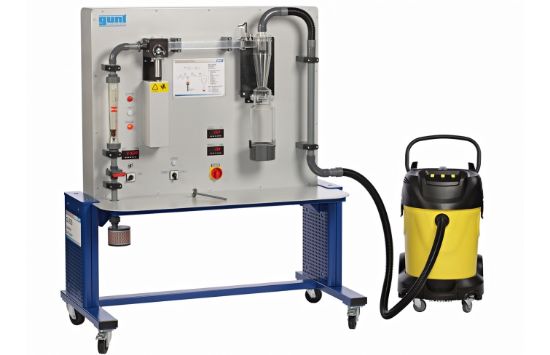One area of application of gas cyclones is the pre-filtration of solids from gases. Gas cyclones have no moving parts, and so are low-maintenance systems. Gas cylones can also be used in conjunction with high gas temperatures. For these reasons they are in widespread use.
This trainer was developed in cooperation with the Institute for Solids Process Engineering and Particle Technology at TU Hamburg-Harburg . A disperser is used to disperse the feed material (quartz powder recommended) finely in an air flow. The air flow laden with solid material (raw gas) in this way is fed tangentially into the cyclone at the top. In the cyclone, the air flow moves downwards as a rotating primary vortex. At the bottom of the cyclone the vortex is reversed. In the middle of the cyclone it moves as a secondary vortex back up towards the immersion tube, where the cleaned gas emerges from the cyclone. The main separation process takes place in the primary vortex. Owing to the centrifugal forces and the difference in density between the air and the solid, the coarse solid particles move towards the wall. They slide down the wall and are collected in a tank at the bottom of the cyclone. No complete separation of the entire solid material takes place. The fine particles which are smaller than the separation size are ideally discharged from the immersion tube at the top with the secondary vortex. This fine material is separated out of the air flow by a filter. The separation size defines the theoretical boundary between the fine and coarse material.
The solid content of the raw gas can be adjusted by means of the disperser and a valve for the volumetric air flow rate. To prevent loading of the air flow with particles upstream of the disperser, the drawn-in room air is filtered. A fan generates the air flow. Pressure measurement points at the relevant positions in the trainer enable to determine the pressure loss.
Using a suitable analysis device (such as a diffraction spectrometer), a separation function can be produced and the separation size determined.

